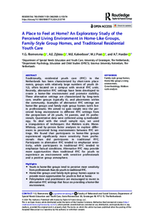Traditionally, residential youth care (RYC) in the Netherlands has been characterized by short-term placements, groups with relatively large numbers of youth (8– 12), often located on a campus with several RYC units. Recently, alternative RYC settings have been developed to create a home-like environment and promote stability. These alternative settings are characterized by long-term care, smaller groups (typically 6), and placements within the community. Examples of alternative RYC settings are home-like groups and family-style group homes (with livein professionals).
The authors aimed to gain insight into the perceived living environment in different RYC settings from the perspectives of 26 youth, 14 parents, and 35 professionals. Quantitative data were collected using q-methodology. To deal with the small sample size, they used a triangulation of techniques: the Mokken scale, MannWhitney, and by-person factor analyses to explore differences in perceived living environments between RYC settings. They found that participants in home-like groups experienced significantly more sensitivity from professionals than did participants in traditional RYC. Participants in alternative RYC tended to emphasize sensitivity, while participants in traditional RYC tended to emphasize factual conditions. Alternative RYC may provide more opportunities than traditional RYC for youth to experience an environment with sensitive professionals and a positive group atmosphere.
Highlights
- Youth in home-like groups tend to perceive more sensitivity from professionals than do youth in traditional RYC.
- Home-like groups and family-style group homes appear to provide more opportunities for youth to feel at home.
- Policymakers and practitioners are encouraged to invest in alternative RYC

